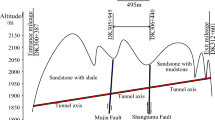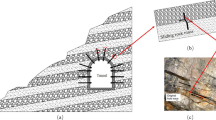Abstract
Large squeezing deformation has always been a critical concern in the construction of deep-buried tunnels in soft-weak rock masses. This paper describes a case study on the large deformation mechanism and supporting method of the Maoxian tunnel in Sichuan Province, China, which is located in the core area influenced by the 2008 Wenchuan earthquake and suffered severe large deformation in broken phyllite under high geo-stress. Through a survey on the geological features, the deformation mechanism of surrounding rock and the failure characteristics of supporting structures of the Maoxian tunnel in F1 fault zone were studied. It was found that the occurrence of large deformation was due to the combined action of the high geo-stress and poor self-stability of carbonaceous phyllite. In order to control the squeezing deformation, single and double primary support methods were adopted in succession. A comparative field test was conducted to study their supporting mechanism and mechanical behavior in terms of surrounding rock pressure, internal stress of the steel arch, and axial force and bending moment of the secondary lining. The results revealed that the single primary support method cannot ensure the long-term safety of the tunnel, since many cracks in concrete occurred after about 180 days. The double primary support method, however, was able to control the large deformation and rheological effects of broken phyllite under high geo-stress effectively.




















Similar content being viewed by others
References
Asghar R, Lohrasb F, Mohammad D (2017) Squeezing rock conditions at phyllite-slate zone in Golab water conveyance tunnel, Iran: A case study. J Cent South Univ 24:2475–2485
Barla G, Bonini M, Semeraro M (2011) Analysis of the behaviour of a yield-control support system in squeezing rock. Tunn Undergr Space Technol 26:146–154
Cao CY, Shi CH, Lei MF, Yang WC, Liu JW (2018) Squeezing failure of tunnels: A case study. Tunn Undergr Space Technol 77:188–203
Chen ZY, Shi C, Li TB, Yuan Y (2012) Damage characteristics and influence factors of mountain tunnels under strong earthquakes. Nat Hazards 61(2):387–401
Dwivedi RD, Singh M, Viladkar MN, Goel RK (2013) Prediction of tunnel deformation in squeezing grounds. Eng Geol 161:55–64
Fan XM, Juang H, Wasowskic J, Huang RQ, Xu Q, Scaringi G, Westen CJ, Havenith HB (2018) What we have learned from the 2008 Wenchuan Earthquake and its aftermath: A decade of research and challenges. Eng Geol 241:25–32
Fang Y, Guo JN, Grasmick J, Mooney M (2016) The effect of external water pressure on the liner behavior of large cross-section tunnels. Tunn Undergr Space Technol 65:167–178
Fortsakis P, Nikas K, Marinos V, Marinos P (2012) Anisotropic behaviour of stratified rock masses in tunnelling. Eng Geol 141–142:74–83
He MC, Gong WL, Wang J, Qi P, Tao ZG, Du S, Peng YY (2014) Development of a novel energy absorbing bolt with extraordinarily large elongation and constant resistance. Int J Rock Mech Min Sci 67:29–42
Hoek E, Guevara R (2009) Overcoming squeezing in the Yacambú-Quibor tunnel, Venezuela. Rock Mech Rock Eng 42:389–418
Huang RQ, Wang Z, Pei SP, Wang YS (2009) Crustal ductile flow and its contribution to tectonic stress in Southwest China. Tectonophysics 473:476–489
Li L, Tan ZS, Y Y JB, Zhang MJ (2017a) Experimental study on primary lining form of tunnels in phyllite on Chengdu-Lanzhou railway. Chin Civil Eng J 50:19–24 (in Chinese)
Li TB, Ma CC, Zhu ML, Meng LB, Chen GQ (2017b) Geomechanical types and mechanical analyses of rockbursts. Eng Geol 222:72–83
Li WT, Yang B, Ma HY, Li TC, Wang Q, Wang G, Du YT, Zhao MX (2018) An improved numerical simulation approach for arch-bolt supported tunnels with large deformation. Tunn Undergr Space Technol 77:1–12
Li YJ, Zhang DL, Fang Q, Yu QC, Xia L (2014) A physical and numerical investigation of the failure mechanism of weak rocks surrounding tunnels. Comput Geotech 61:292–230
Manh HT, Sulem J, Subrin D, Billaux D (2015) Anisotropic time-dependent modeling of tunnel excavation in squeezing ground. Rock Mech Rock Eng 48:2301–2317
Meng LB, Li TB, Jiang Y, Wang R, Li YR (2013) Characteristics and mechanics of large deformation in the Zhegu mountain tunnel on the Sichuan-Tibet highway. Tunn Undergr Space Technol 37:157–164
National Railway Administration of PRC (2017) Code for Design on Railway Tunnel. China Railway Press, Beijing
Shi SS, Xie XK, Bu L, Li LP, Zhou ZQ (2018) Hazard-based evaluation model of water inrush disaster sources in karst tunnels and its engineering application. Environ Earth Sci 77(4):141
Shen YS, Gao B, Yang XM, Tao SJ (2014) Seismic damage mechanism and dynamic deformation characteristic analysis of mountain tunnel after Wenchuan earthquake. Eng Geol 180:85–98
Tao ZG, Zhao F, Wang HJ, Zhang HJ, Peng YY (2017) Innovative constant resistance large deformation bolt for rock support in high stressed rock mass. Arab J Geosci 10:341–355
Xu F, Li SC, Zhang QQ, Li LP, Shi SS, Zhang Q (2017) A new type support structure introduction and its contrast study with traditional support structure used in tunnel construction. Tunn Undergr Space Technol 63:171–182
Xu GW, He C, Su A, Chen ZQ (2018a) Experimental investigation of the anisotropic mechanical behavior of phyllite under triaxial compression. Int J Rock Mech Min Sci 104:100–112
Xu GW, He C, Chen ZQ, Su A (2018b) Effects of the micro-structure and micro-parameters on the mechanical behaviour of transversely isotropic rock in Brazilian tests. Acta Geotech 13:887–910
Xu GW, He C, Wang Y, Wang B (2016) Study on the safety performance of cracked secondary lining under action of rheological load. Chin Civil Eng J 49:114–123 (in Chinese)
Yang SQ, Chen M, Jing HW, Chen KF, Meng B (2017) A case study on large deformation failure mechanism of deep soft rock roadway in Xin’An coal mine, China. Eng Geol 217:89–101
Zhang C, Feng XT, Zhou H (2012a) Estimation of in situ stress along deep tunnels buried in complex geological conditions. Int J Rock Mech Min Sci 52:139–162
Zhang GH, Jiao YY, Wang H (2014) Outstanding issues in excavation of deep and long rock tunnels: a case study. Can Geotech J 51:984–994
Zhang ZQ, Chen FF, Li N, Swoboda G, Liu NF (2017) Influence of fault on the surrounding rock stability of a tunnel: Location and thickness. Tunn Undergr Space Technol 61:1–11
Zhang ZX, Xu Y, Kulatilake PHSW, Huang X (2012b) Physical model test and numerical analysis on the behavior of stratified rock masses during underground excavation. Int J Rock Mech Min Sci 49:134–147
Zou YL, He C, Zhou Y, Wang B, Xu JH (2013) Analysis of supporting effect of systematic bolts applied to weak and broken phyllite tunnels in meizoseismal area. Rock Soil Mech 34:2000–2008 (in Chinese)
Acknowledgments
This research was supported by the National Key R&D Program of China (No. 2016YFC0802210) and 2017 Doctoral Innovation Fund Program of Southwest Jiaotong University.
Author information
Authors and Affiliations
Corresponding author
Rights and permissions
About this article
Cite this article
Chen, Z., He, C., Xu, G. et al. Supporting mechanism and mechanical behavior of a double primary support method for tunnels in broken phyllite under high geo-stress: a case study. Bull Eng Geol Environ 78, 5253–5267 (2019). https://doi.org/10.1007/s10064-019-01479-1
Received:
Accepted:
Published:
Issue Date:
DOI: https://doi.org/10.1007/s10064-019-01479-1




